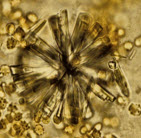|
Amorphous phosphates
 Amorphous
phosphates is the name given to a granular precipitate containing
calcium and phosphate in an alkaline urine. Calcium phosphate
crystals, regrouped under the term apatite, have mineralogical
names that differ according to their chemical composition. The
CaH2PO4*(2H2O) is called Brushite, the calcium hydroxyl phosphate
is called hydroxyl-apatite, the calcium bicarbonate phosphate is
called Dahlite or carbonate-apatite.
Amorphous
phosphates is the name given to a granular precipitate containing
calcium and phosphate in an alkaline urine. Calcium phosphate
crystals, regrouped under the term apatite, have mineralogical
names that differ according to their chemical composition. The
CaH2PO4*(2H2O) is called Brushite, the calcium hydroxyl phosphate
is called hydroxyl-apatite, the calcium bicarbonate phosphate is
called Dahlite or carbonate-apatite.
The main cause of this crystalluria is the alkaline pH that decreases the solubility of the calcium phosphate and entails a precipitation of the former. The alkaline pH can be caused by the diet (vegetarian, rich in phosphates..) but can also represent a pathological situation. Usually, the presence of these crystals is non significant. The distinction between amorphous urates and amorphous phosphates is often made on the urinary pH basis. With a simple examination of the centrifuge pellet, the precipitate of calcium phosphate is white, while that amorphous urate is pink.
Triple phosphates
(Magnesium ammonium phosphates)
(Struvite)
 Triple phosphates are found in urines whose pH
is superior to 6,5. The former crystallize in the orthorombic
system. The crystal is slightly birefringent and often shows a
polarization color. The classic shape is the pyramid, that
reminds a coffin lid. The crystalluria is usually polymorphous.
The rosette-shaped crystal shown in the picture bank has been
observed in a specimen with a pH of 6,5.
Triple phosphates are found in urines whose pH
is superior to 6,5. The former crystallize in the orthorombic
system. The crystal is slightly birefringent and often shows a
polarization color. The classic shape is the pyramid, that
reminds a coffin lid. The crystalluria is usually polymorphous.
The rosette-shaped crystal shown in the picture bank has been
observed in a specimen with a pH of 6,5.
The primary factor to the triple phosphate crystals formation is the ammonia concentration. Alkalanisation of a urine specimen with ammonia generates triple phosphates while alkalanisation with sodium hydroxide does not. A normal freshly voided specimen contains little free ammonia; this substance is mainly generated by urea splitting bacteria. Triple phosphates are usualy associated with bacterial growth. With a first-morning fresh specimen, triple phosphates can indicate urinary tract infection. Otherwise, triple phosphates are of little clinical value.
Calcium phosphate (hydroxyapatite ) (brushite)
 The calcium phosphate crystals are also named di-calcium phosphate or hydroxyl-apatite. Its mineral name is brushite CaH2PO4(2H2O). This substance crystallizes as a long prism with one sharped end. These crystals are slightly birefringent.Calcium phosphate crystals are often found with triple phosphates and their clinical meaning is identical.
The calcium phosphate crystals are also named di-calcium phosphate or hydroxyl-apatite. Its mineral name is brushite CaH2PO4(2H2O). This substance crystallizes as a long prism with one sharped end. These crystals are slightly birefringent.Calcium phosphate crystals are often found with triple phosphates and their clinical meaning is identical.